Flexural Properties in Edgewise Bending of LVL Reinforced with Woven Carbon Fibers
Abstract
1. Introduction
1.1. The Research Subject and Objectives
1.2. Literature Review
2. Materials and Methods
2.1. Veneer Preparation
2.2. Adhesives
2.3. Woven Carbon Fiber
2.4. Manufacturing LVL
- Combination 1 (K1)—reinforcement placed in the first and sixth gluelines (S1║6║), unidirectionally oriented, carbon fibers placed longitudinally, parallel to the grain of the outer veneer;
- Combination 2 (K2)—reinforcement placed in the first and sixth gluelines, parallel-oriented as outer veneer, and the third and fourth gluelines, perpendicular to the direction of orientation of the outer veneer sheets (S1║3┴4┴6║);
- Combination 3 (K3)—reinforcement placed in two layers perpendicular to each other, forming a mesh in two directions. The fabrics are placed in the first and sixth gluelines (S1║┴6┴║), taking into account the symmetry of the cross-section;
- Combination 4 (K4)—unreinforced panels, i.e., control reference samples.
2.5. Tests of Mechanical Properties
3. Results and Discussion
3.1. Bending Behavior and Failure Mode
3.1.1. Epoxy Adhesive Samples (EK)
3.1.2. Melamine-Urea Formaldehyde Adhesive Samples (MK)
3.2. Load-Bearing Capacity
3.2.1. Epoxy Adhesive (EK) Samples
3.2.2. Melamine Urea Formaldehyde Adhesive (MK) Samples
3.3. Summary
- The percentage of improvement in bending strength for panels of type EK1 = 32.9%, EK2 = 33.2%, and EK3 = 38.7% compared to control panels, while the percentage of increase in modulus of elasticity is 54.1%, 50.7%, and 54.7% for EK1, EK2, and EK3, respectively.
- The fracture of all reinforced and unreinforced test samples glued with epoxy adhesive occurred as a brittle fracture in the tensile zone of the section;
- When the maximum critical force was applied in the upper, compressed zone of the section, the test sample was crushed, the wood fibers were compressed, and to a small extent, the FRP-wood layers delaminated; the fracture occurred due to compressive stress;
- In all test samples made of reinforced epoxy panels, the fracture in the wood was explosive, brittle, and mostly accompanied by the tearing of a smaller number of carbon fibers in the tension zone of the section;
- In the case of test samples made from EK3 panels, delamination does not occur due to exceeding the compressive strength, and fiber breakage occurs only in a few test samples and to a much lesser extent;
- The zone of plastic behavior before fracture in the test samples from EK3 panels is almost negligible. For specific test samples, the load intensity decreases after breaking, then increases again, and then permanently decreases;
- Panels EK2 and EK3 reinforced with fibers set in two directions may have an advantage for other types of loading, especially for improving shear strength or pressure in the plane of the panel, perpendicular to the grain;
- Carbon fibers oriented in the longitudinal direction, i.e., in the direction of the grain, affect the reduction of the variability of the results during bending and contribute to a more uniform behavior of the structure;
- Carbon fibers oriented parallel to the grain, united through the pressed and tensioned zone of the section during bending, do not affect the shape of the fracture. In both reinforced and non-reinforced test samples, the fracture is brittle in the tensioned zone. However, when it comes to non-reinforced test samples, the fracture is explosive, sudden, and complete, splitting the sample in two;
- Adhesion failure that occurred in the stressed zone between the FRP-wood and FRP-FRP layers in the test samples made of reinforced panels glued with epoxy adhesive occurred exclusively after the fracture in the wood;
- During the testing of panels made of MUF adhesive, before the test sample breaks due to excessive force, delamination of the test sample occurs between the FRP-FRP layers in MK3 panels or the FRP-wood layer in MK1 panels;
- Control panels glued with MUF with this adhesive show higher values of bending strength and modulus of elasticity compared to control panels glued with epoxy adhesive. This indicates that water-based glue is more favorable for gluing the wood itself due to its better penetration into the wood layer. However, due to the adhesion between FRP and wood as well as FRP-FRP glue, MUF is unsuitable for application.
4. Conclusions
- MUF adhesive is unsuitable for gluing synthetic fibers to each other or synthetic and wood fibers, and in veneer-veneer adhesion it is stable, but then breakage occurs on the wood during tests. Epoxy adhesive is applicable in all tested combinations.
- By reinforcing the LVL with carbon fibers and using epoxy adhesive, higher values of edgewise bending strength and modulus of elasticity are achieved.
- The edgewise bending strength and modulus of elasticity of reinforced LVL were significantly greater than those of unreinforced LVL, and the percentage of improvement for the EK3 combination are 38.7% and 54.7%, respectively. However, the most optimal strengthening from the aspect of material consumption and improvement of mechanical characteristics was achieved with reinforced panels of type EK1.
- All tested reinforced samples suffered much less deformation at much higher forces compared to unreinforced ones, which was contributed by the carbon fibers and their behavior in the tensioned section zone, where the sudden brittle fracture occurs in unreinforced samples.
Author Contributions
Funding
Institutional Review Board Statement
Informed Consent Statement
Data Availability Statement
Acknowledgments
Conflicts of Interest
References
- Laufenberg, T.L.; Rowlands, R.E.; Krueger, G.P. Economic feasibility of synthetic fiber reinforced laminated veneer lumber (LVL). For. Prod. J. 1984, 34, 15–22. [Google Scholar]
- Bulleit, W.M. Reinforcment of wood materials: A review. Wood Fiber Sci. 1984, 3, 391–397. [Google Scholar]
- Biblis, E.J.; Carino, H.F. Flexural properties of Southern Pine plywood overlaid with fiberglass-reinforced plastic. For. Prod. J. 2000, 50, 34–36. [Google Scholar]
- Van Acker, J. ProPopulus: The European Poplar Initiative, PROPOPULUS: 2022. Available online: https://propopulus.eu/wp-content/uploads/2022/06/ProPopulus_The-European-Poplar-Initiative_poplar-in-a-sustainable-economy.pdf (accessed on 15 September 2022).
- Bal, B.C. Some technological properties of laminated veneer lumber produced with fast-growing Poplar and Eucalyptus. Cienc. Tecnol. 2016, 18, 413–424. [Google Scholar] [CrossRef]
- Xue, B.; Hu, Y. Mechanical properties analysis and reliability assessment of laminated veneer lumber (LVL) having different patterns of assembly. Bioresources 2012, 7, 1617–1632. [Google Scholar] [CrossRef]
- Zdravković, V.; Lovrić, A.; Džinčić, I.; Pantović, N. Some Properties of LVL Composed of Poplar and Beech Veneer and Possibilities of Their Application for Window Frames. Glas. Sumar. Fak. 2017, 115, 167–184. Available online: http://www.doiserbia.nb.rs/img/doi/0353-4537/2017/0353-45371715167Z.pdf (accessed on 8 April 2023). [CrossRef]
- Timbolmas, C.I. Development of Engineering Wood Products Based on Poplar Boards and Veneers with Composite Material Insertions for Use in Construction. Ph.D. Thesis, Universidad de Granada, Granada, Spain, 2022. Available online: http://hdl.handle.net/10481/75454 (accessed on 8 April 2023).
- Laufenberg, T.L. Parallel-laminated veneer: Processing and performance research review. For. Prod. J. 1983, 33, 21–28. [Google Scholar]
- Wei, P.X.; Zhou, D.G. Prospect and application of wood-based panels for electromechanical packaging. China For. Sci. Technol. 2012, 26, 13–16. [Google Scholar]
- Sasaki, H.; Abdullahi, A.A. Lumber: Laminated Veneer. In Reference Module in Materials Science and Materials Engineering; Elsevier: Amsterdam, The Netherlands, 2016. [Google Scholar]
- Sokolović, N.; Kontić, A.; Josifovski, A. Application of veneer based panels in exoskeleton architecture. In Keeping Up with Technologies to Act Responsively in Urban Environment, Proceedings of the International Academic Conference on Places and Technologies, Online, 29–30 October 2020; Djukić, A., Krstić-Furundžić, A., Lazarević, E.V., Vukmirović, M., Eds.; University of Belgrade, Faculty of Architecture: Belgrade, Serbia, 2020; Volume 7, pp. 180–187. [Google Scholar]
- Brezović, M.; Jambreković, V.; Pervan, S. Bending properties of carbon fiber reinforced plywood. Wood Res. 2003, 48, 13–24. [Google Scholar]
- Brezović, M.; Kljak, J.; Pervan, S.; Antonović, A. Utjecaj kuta orijentacije sintetičkih vlakana na savojna svojstva kompozitne furnirske ploče. Drv. Ind. 2010, 61, 239–243. [Google Scholar]
- Xu, H.; Nakao, T.; Tanaka, C.; Yoshinobu, M.; Katayama, H. Effects of fiber length and orientation on elasticity of fiber-reinforced plywood. J. Wood Sci. 1998, 44, 343–347. [Google Scholar] [CrossRef]
- Brezović, M.; Jambreković, V.; Kljak, J. Utjecaj karbonskih vlakana na neka relativna svojstva furnirskih ploča. Drv. Ind. 2002, 53, 23–31. [Google Scholar]
- Bal, B.C.; Bektaş, İ.; Mengeloğlu, F.; Karakuş, K.; Demir, H.Ö. Some technological properties of poplar plywood panels reinforced with glass fiber fabric. Constr. Build. Mater. 2015, 101 Pt 1, 952–957. [Google Scholar] [CrossRef]
- Bal, B.C. Flexural properties, bonding performance and splitting strength of LVL reinforced with woven glass fiber. Constr. Build. Mater. 2014, 51, 9–14. [Google Scholar] [CrossRef]
- Bal, B.C. Some physical and mechanical properties of reinforced laminated veneer lumber. Constr. Build. Mater. 2014, 68, 120–126. [Google Scholar] [CrossRef]
- Bal, B.C.; Bektaş, İ. The effects of wood species, load direction, and adhesives on bending properties of laminated veneer lumber. BioResources 2012, 7, 3104–3112. [Google Scholar] [CrossRef]
- Auriga, R.; Gumowska, A.; Szymanowski, K.; Wronka, A.; Robles, E.; Ocipka, P.; Kowaluk, G. Performance properties of plywood composites reinforced with carbon fibers. Compos. Struct. 2020, 248, 112533. [Google Scholar] [CrossRef]
- Liu, Y.; Guan, M.; Chen, X.; Zhang, Y.; Yhou, M. Flexural properties evaluation of carbon-fiber fabric reinforced poplar/eucalyptus composite plywood formwork. Compos. Struct. 2019, 224, 111073. [Google Scholar] [CrossRef]
- Choi, S.W.; Rho, J.W.; Lee, D.E.; Lee, W.I. Analysis of buckling load of fiber-reinforced plywood plates. In Proceedings of the 18th International Conference on Composite Materials, Jeju Island, Republic of Korea, 21–26 August 2011. [Google Scholar]
- Choi, S.W.; Li, M.; Lee, W.I.; Kim, H.S. Analysis of buckling load of glass fiber/epoxy-reinforced plywood and its temperature dependence. J. Compos. Mater. 2014, 48, 2191–2206. [Google Scholar] [CrossRef]
- Wang, J.; Guo, X.; Zhong, W.; Wang, H.; Cao, P. Evaluation of Mechanical Properties of Reinforced Poplar Laminated Veneer Lumber. BioResources 2015, 10, 7455–7465. [Google Scholar] [CrossRef]
- Bakalarz, M.M.; Kossakowski, P.G. Ductility and Stiffness of Laminated Veneer Lumber Beams Strengthened with Fibrous Composites. Fibers 2022, 10, 21. [Google Scholar] [CrossRef]
- Bakalarz, M.; Kossakowski, P. The Flexural Capacity of Laminated Veneer Lumber Beams Strengthened with AFRP and GFRP Sheets. Tech. Trans. 2019, 116, 85–95. [Google Scholar] [CrossRef]
- Rescalvo, J.F.; Duriot, R.; Pot, G.; Gallego, A.; Denaud, L. Enhancement of bending properties of Douglas-fir and poplar laminate veneer lumber (LVL) beams with carbon and basalt fibers reinforcement. Constr. Build. Mater. 2020, 263, 120185. [Google Scholar] [CrossRef]
- Bakalarz, M.M.; Kossakowski, P.G. Strengthening of Full-Scale Laminated Veneer Lumber Beams with CFRP Sheets. Materials 2022, 15, 6526. [Google Scholar] [CrossRef]
- Bakalarz, M.M.; Kossakowski, P.G.; Tworzewski, P. Strengthening of Bent LVL Beams with Near-Surface Mounted (NSM) FRP Reinforcement. Materials 2020, 13, 2350. [Google Scholar] [CrossRef]
- Subhani, M.; Globa, A.; Al-Ameri, R.; Moloney, J. Bending strengthening of LVL beam using CFRP. Constr. Build. Mater. 2017, 150, 480–489. [Google Scholar] [CrossRef]
- Wei, P.; Wang, B.J.; Zhou, D.; Dai, C.; Wang, Q.; Huang, S. Mechanical properties of poplar laminated veneer lumber modified by carbon fiber reinforced polymer. BioResource 2013, 8, 4883–4898. [Google Scholar] [CrossRef]
- Rescalvo, F.J.; Duriot, R.; Pot, G.; Gallego, A. Mechanical behavior of poplar laminated veneer lumber with fiber reinforced polymer under shear and compression stresses. Wood Mater. Sci. Eng. 2022. [Google Scholar] [CrossRef]
- MapeWrap31 Technical Data Sheet. Mapei. Available online: https://www.mapei.com/nz/en/products-and-solutions/products/detail/mapewrap-31 (accessed on 4 March 2023).
- Akzo Nobel. AkzoNobel 1247/2526 Techical Data Sheet; Akzo Nobel: Stockholm, Sweden, 2017. [Google Scholar]
- SRPS EN 827:2009; Adhesives—Determination of Conventional Solids Content and Constant Mass Solids Content. ИСС: Belgrade, Serbia, 2020.
- MapeWrap C UNI-AX Technical Data Sheet. Mapei. Available online: https://www.mapei.com/nz/en/products-and-solutions/products/detail/mapewrap-c-uni-ax (accessed on 4 March 2023).
- SRPS EN 14374:2012; Timber Structures—Structural Laminated Veneer Lumber—Requirements. ИСС: Belgrade, Serbia, 2012.
- SRPS EN 408:2014; Timber Structures—Structural Timber and Glued Laminated Timber—Determination of Some Physical and Mechanical Properties. ИСС: Belgrade, Serbia, 2014.
- SRPS EN 789:2012; Timber Structures—Test Methods—Determination of Mechanical Properties of Wood Based Panels. ИСС: Belgrade, Serbia, 2012.
- SRPS EN 325:2014; Wood-Based Panels—Determination of Dimensions of Test Pieces. ИСС: Belgrade, Serbia, 2014.
- SRPS EN 322:2010; Wood-Based Panels—Determination of moisture Content. ИСС: Belgrade, Serbia, 2010.
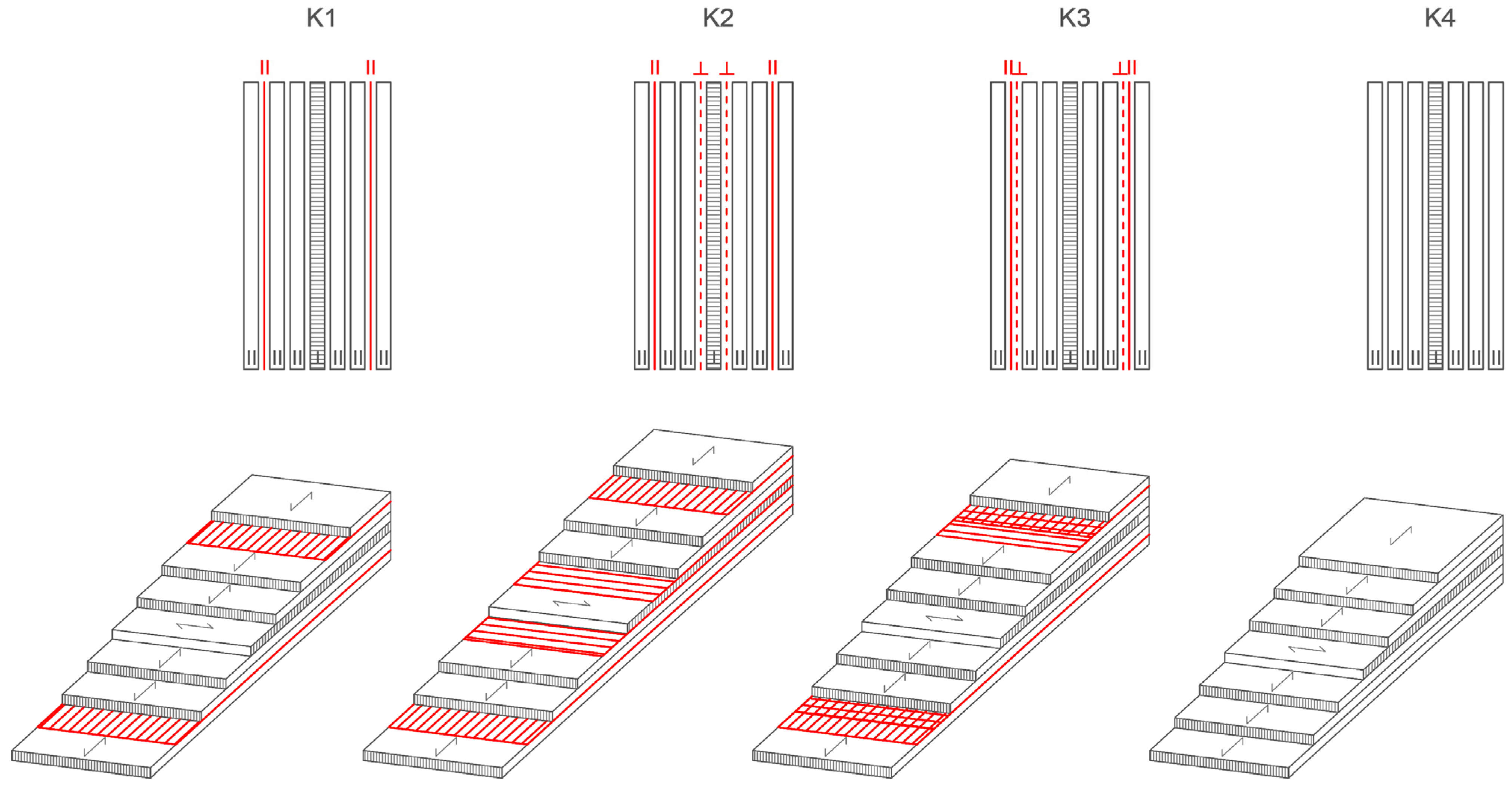
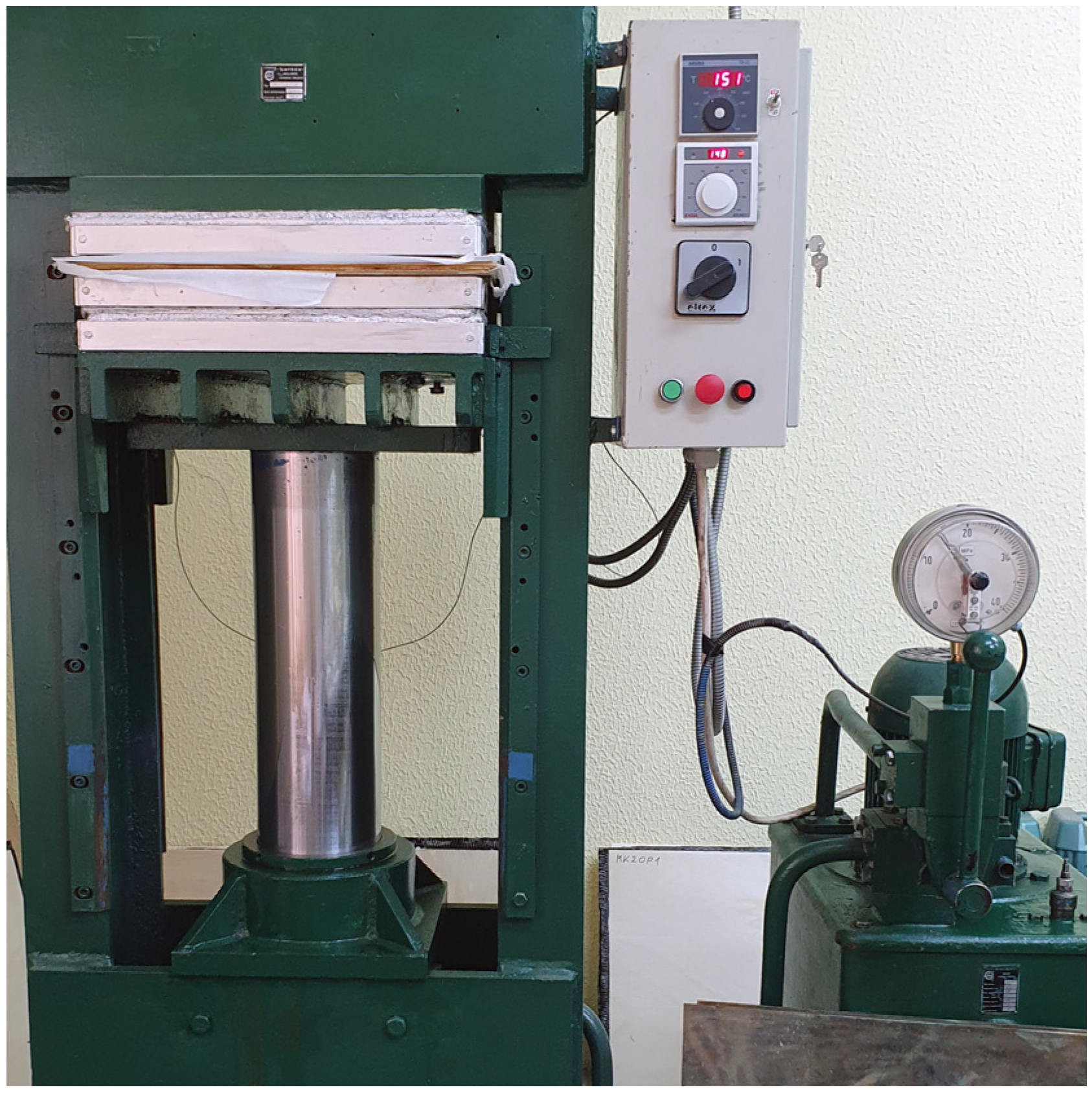
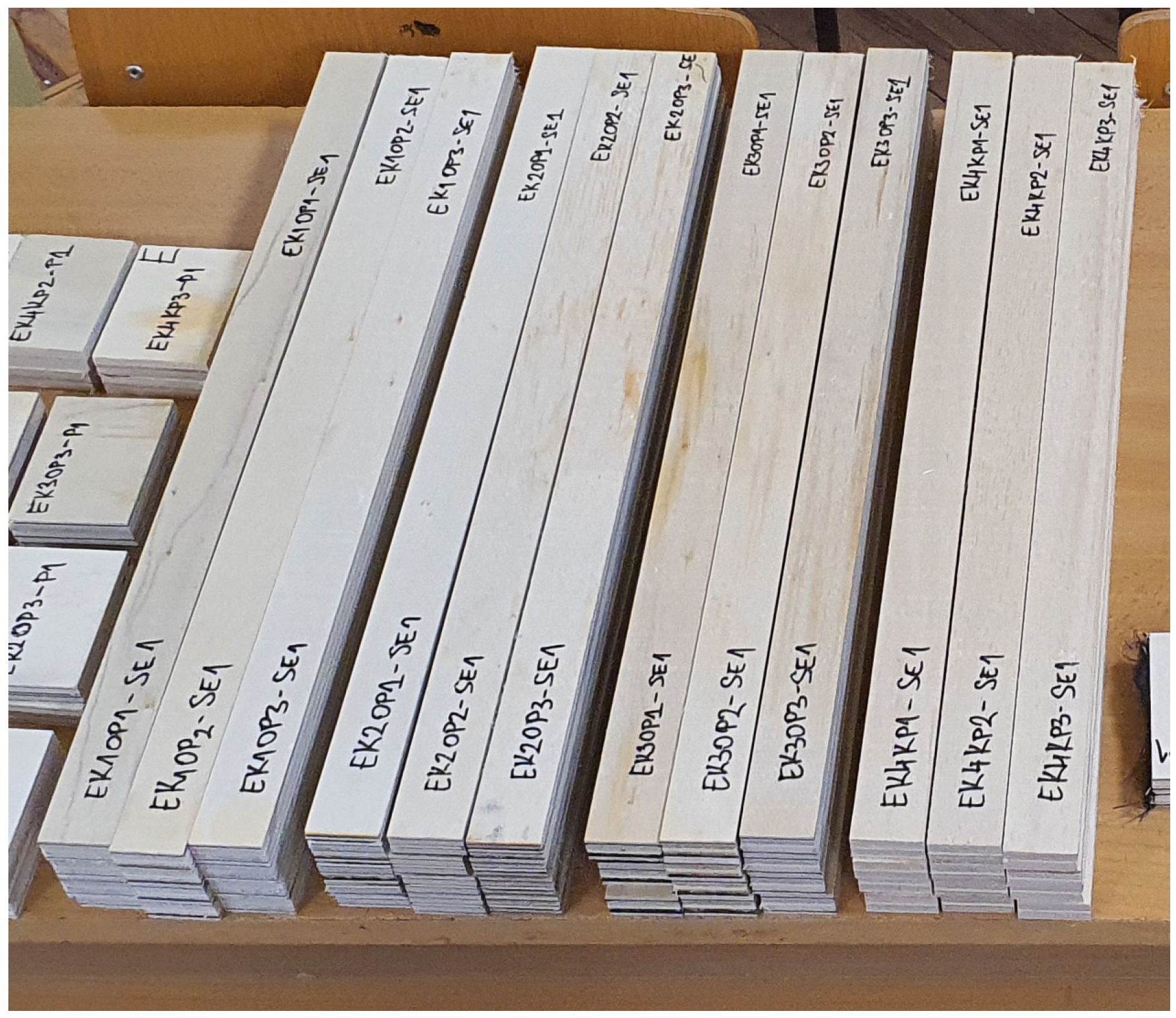

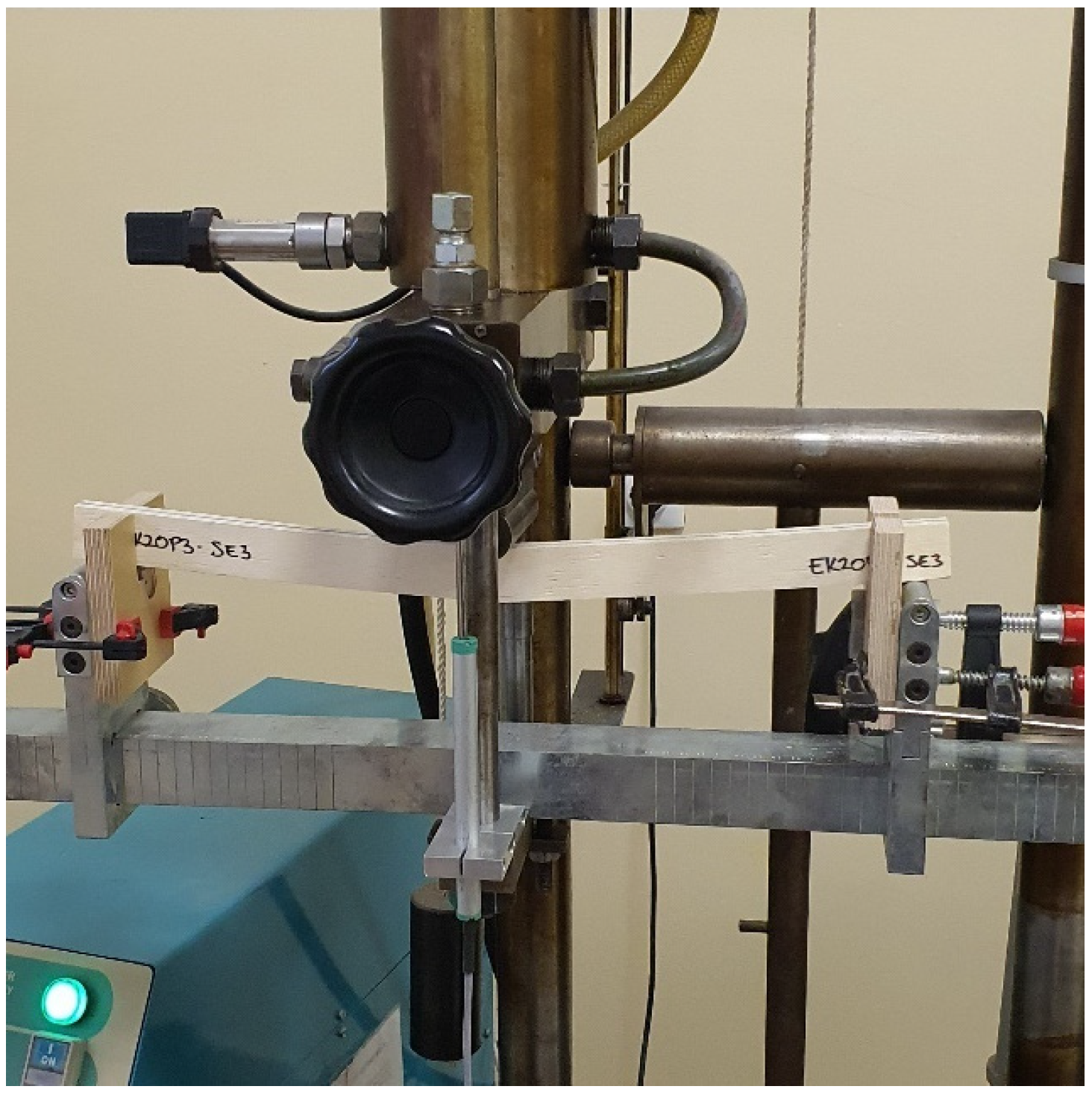
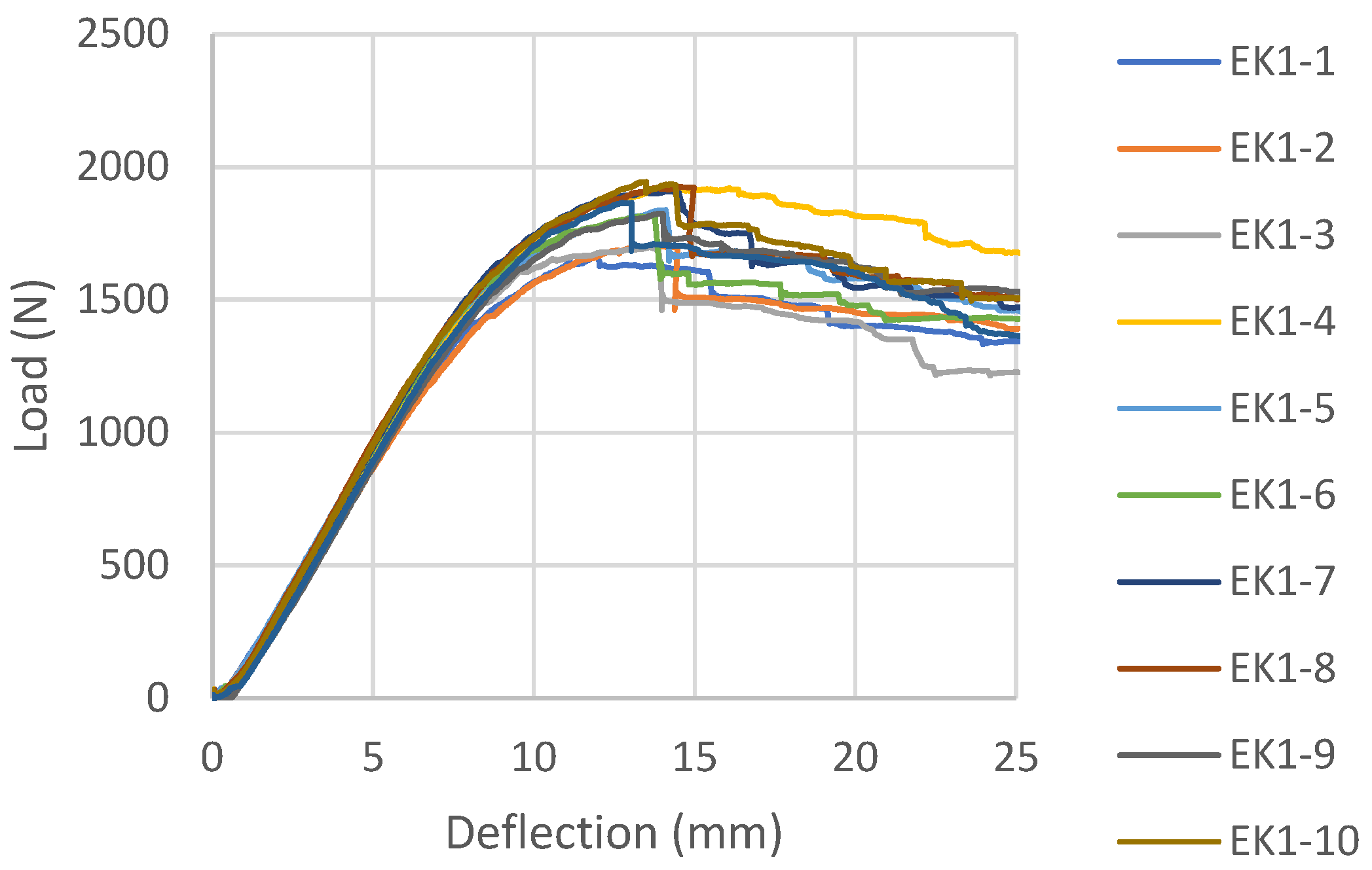
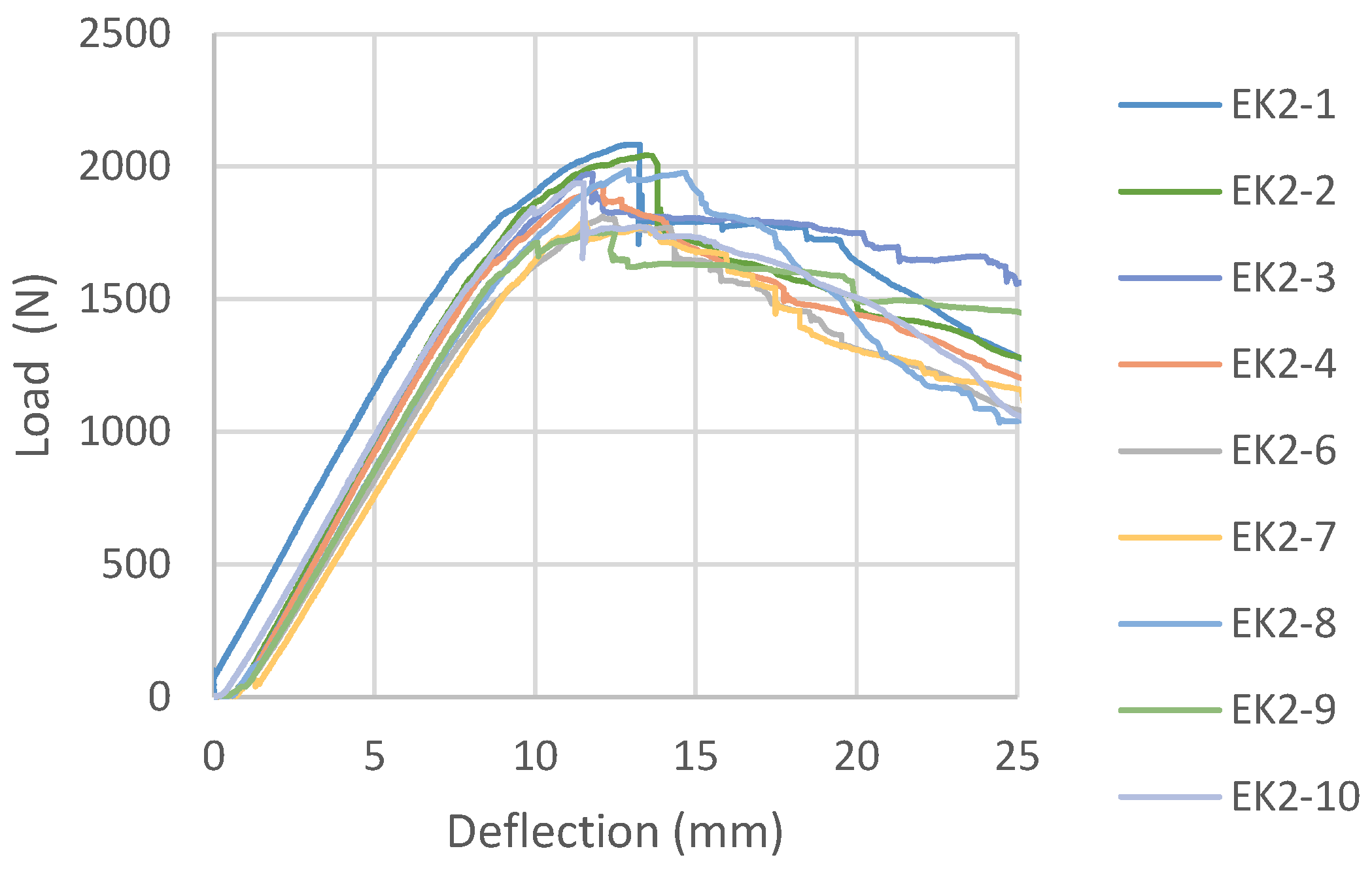
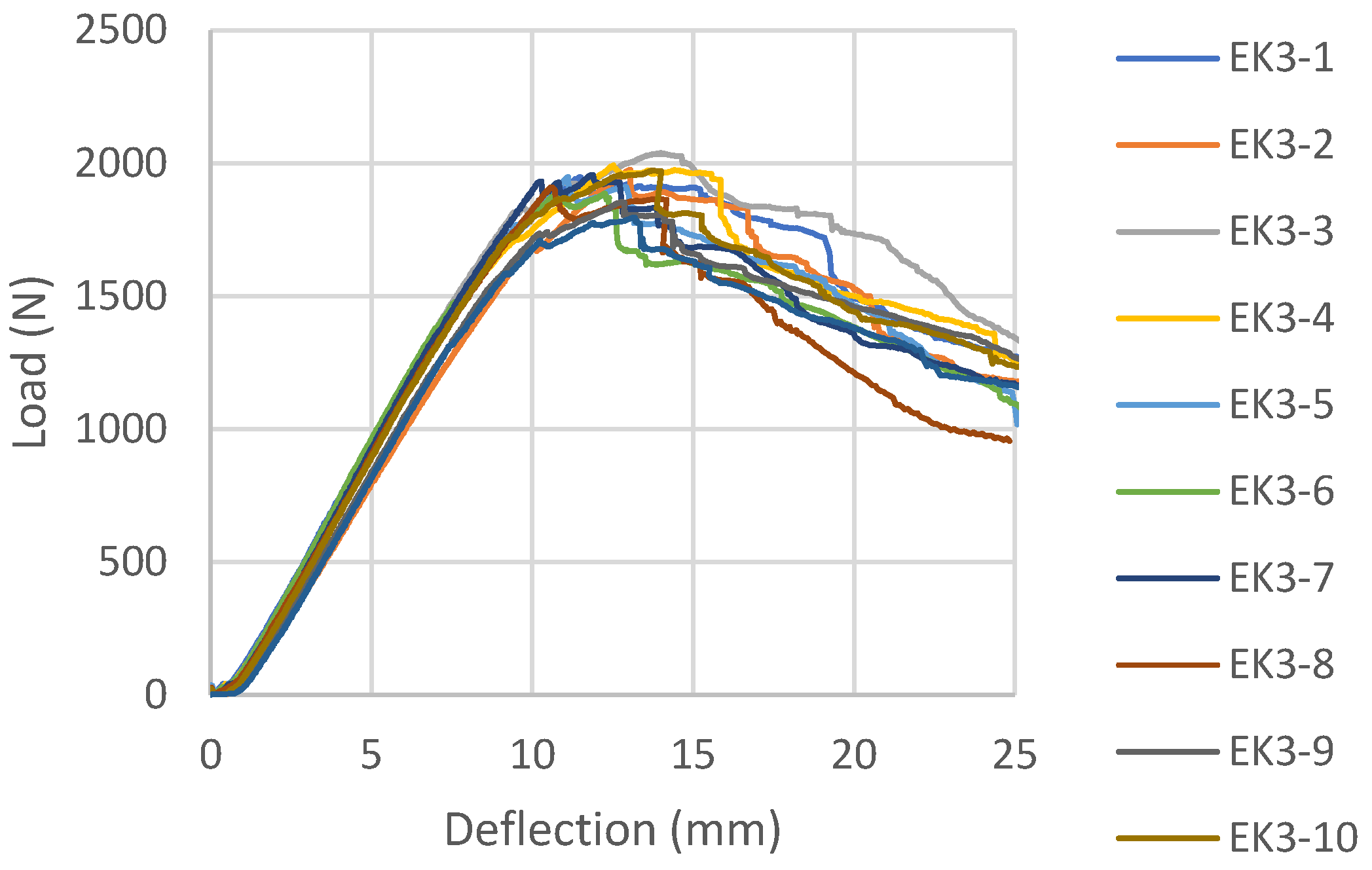
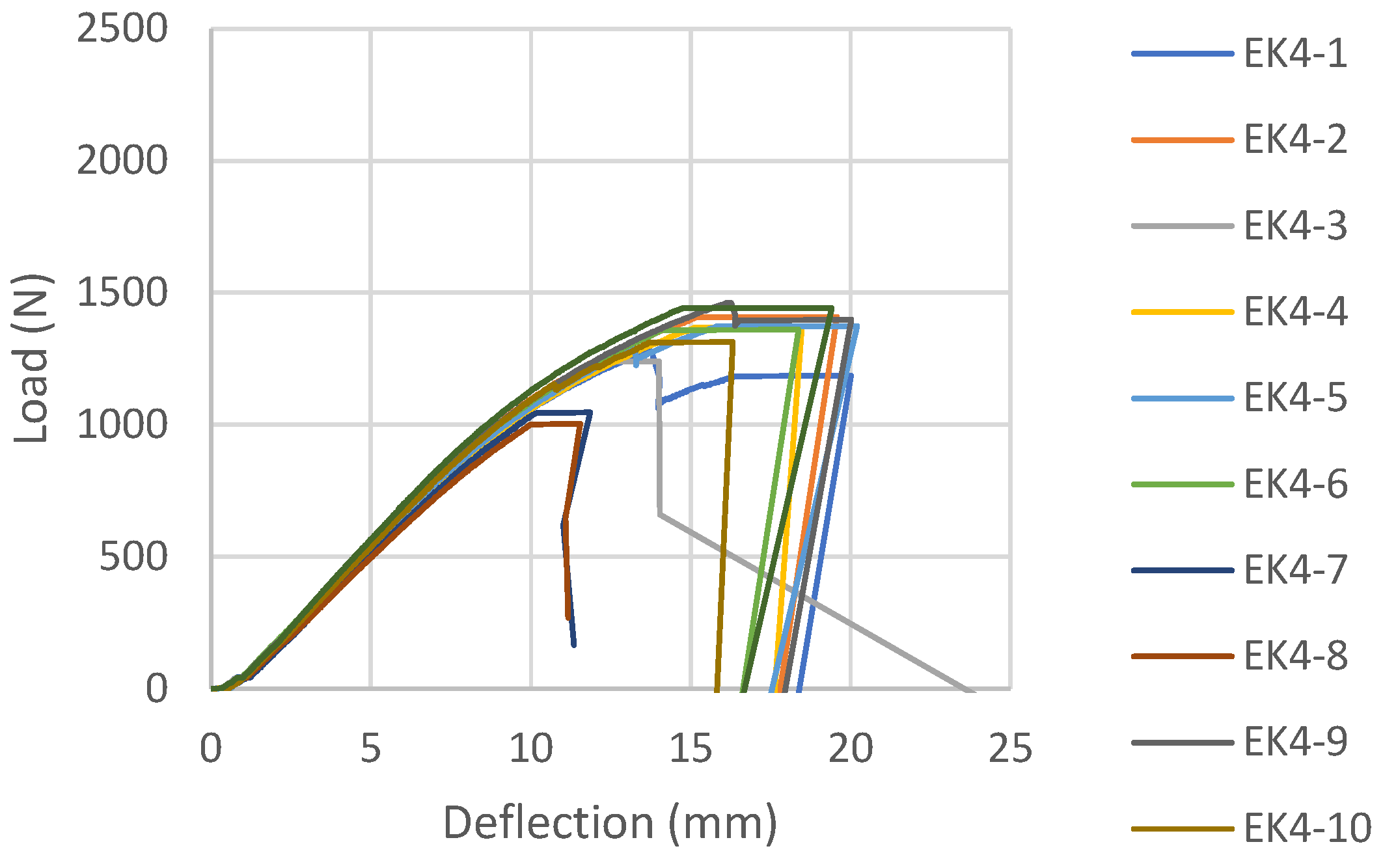
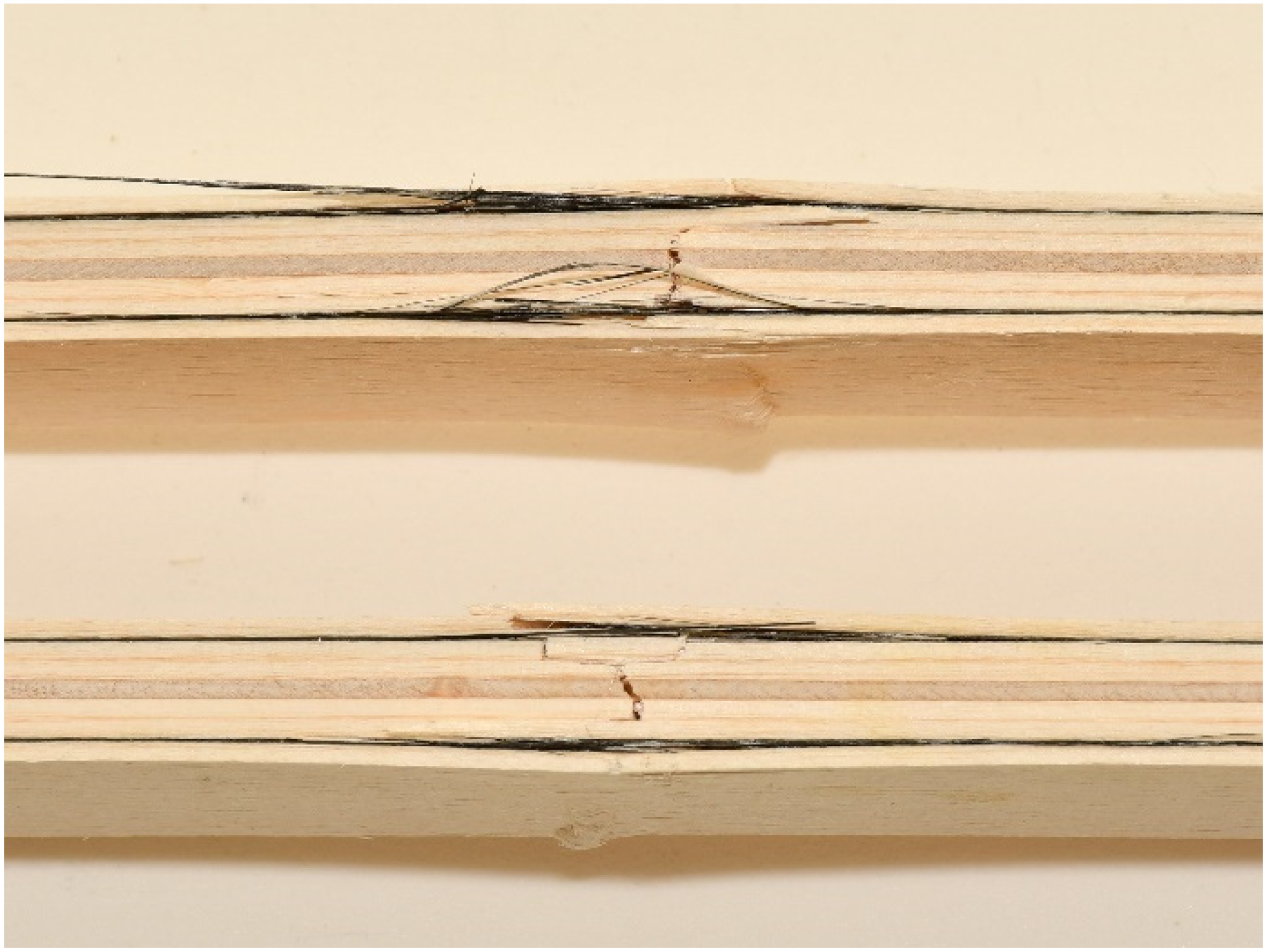
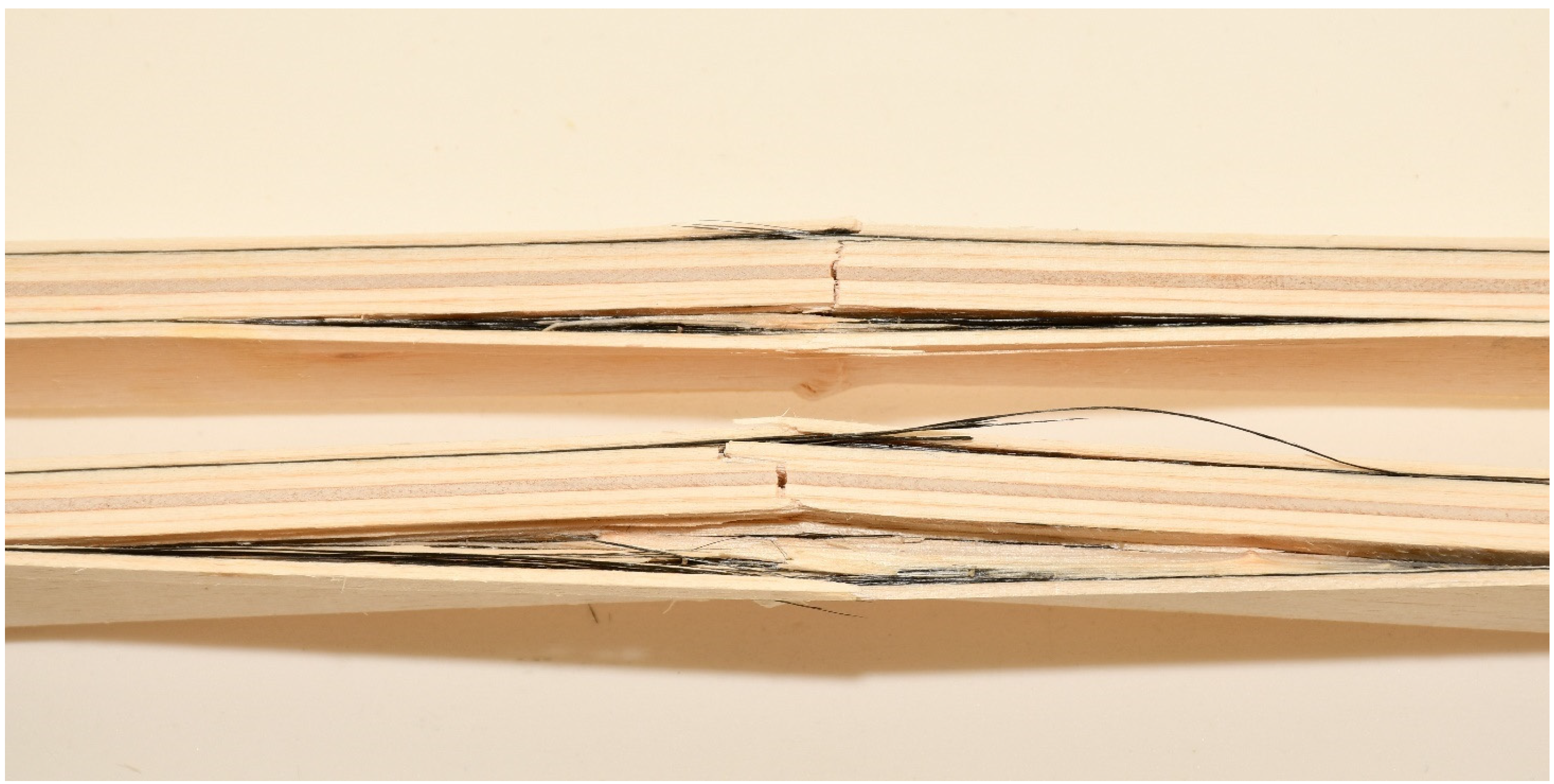
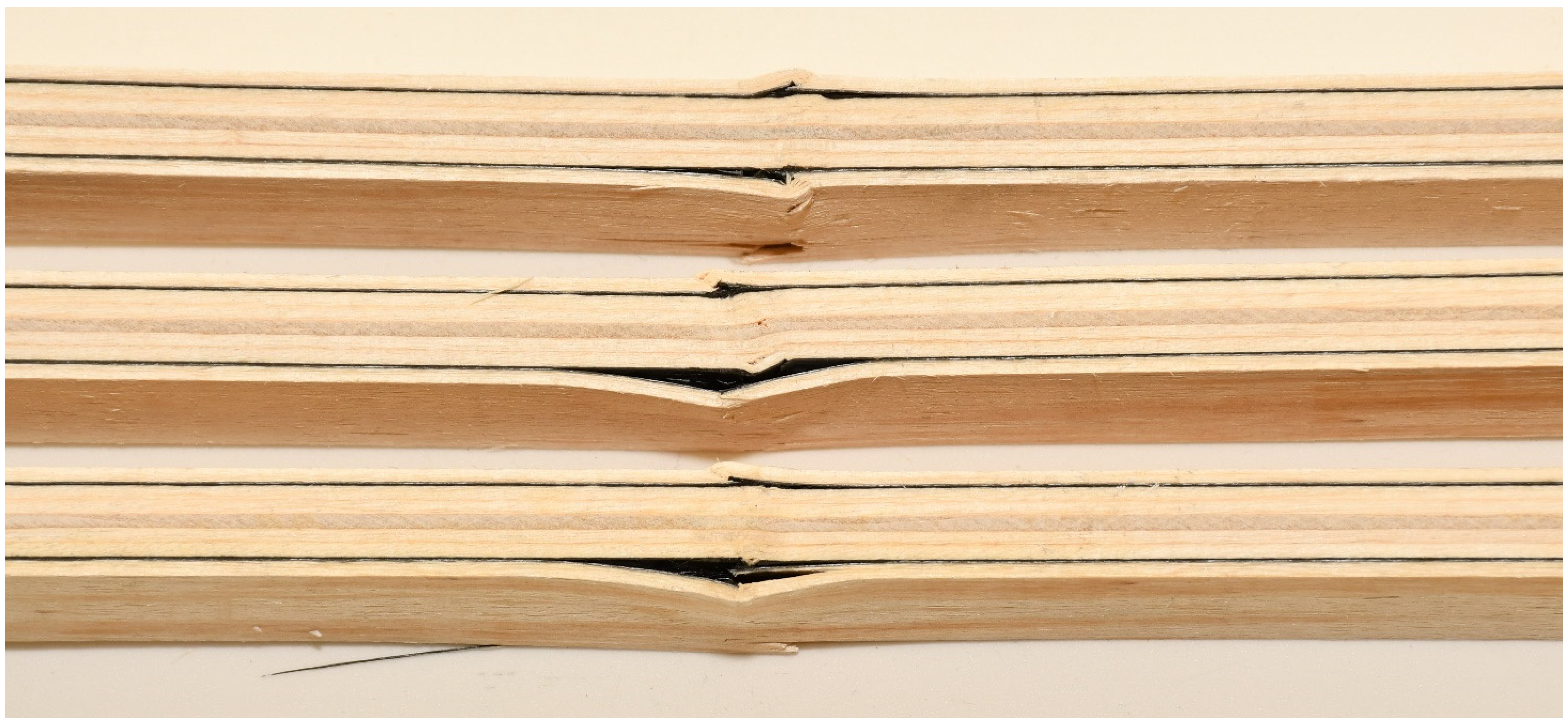

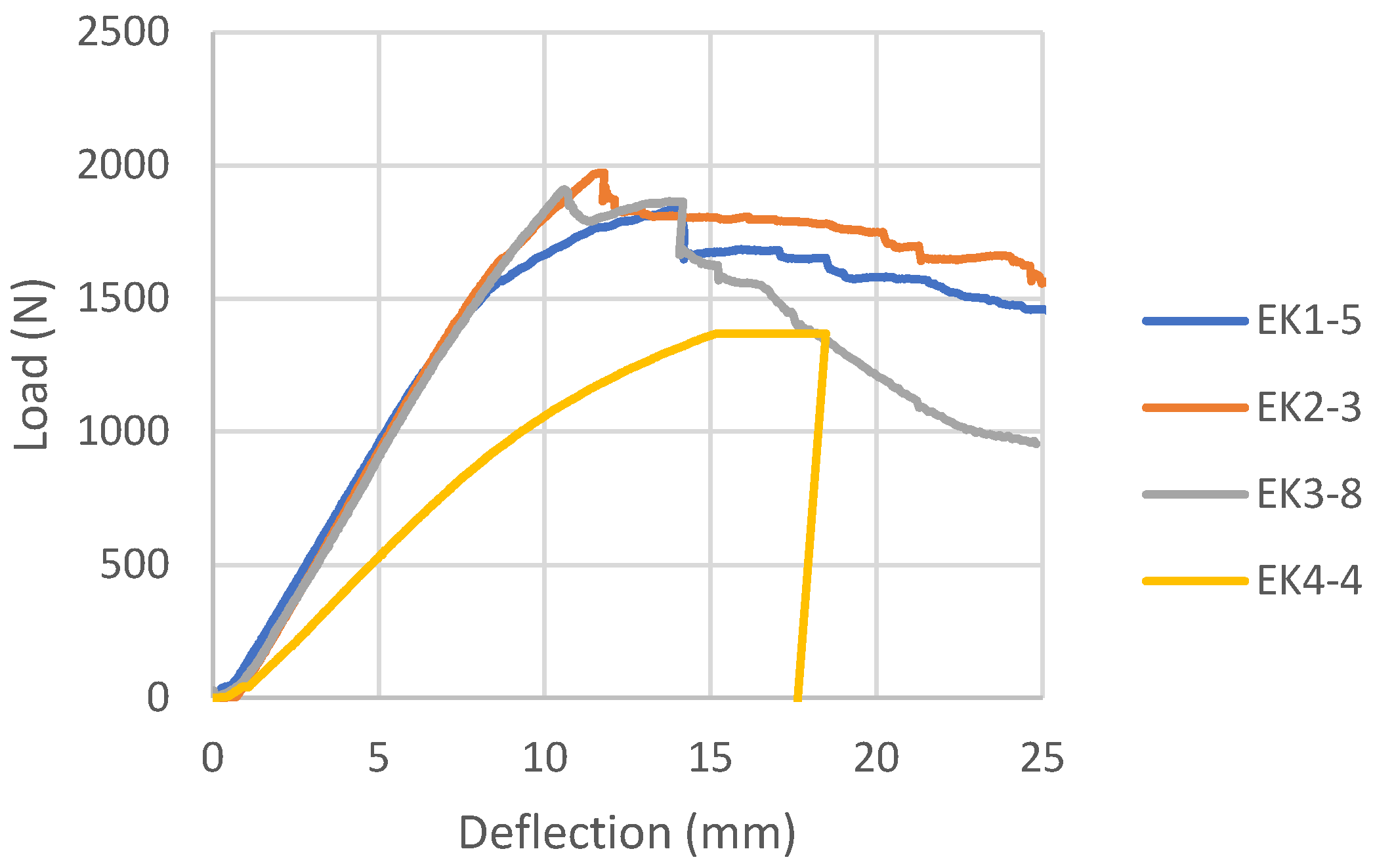
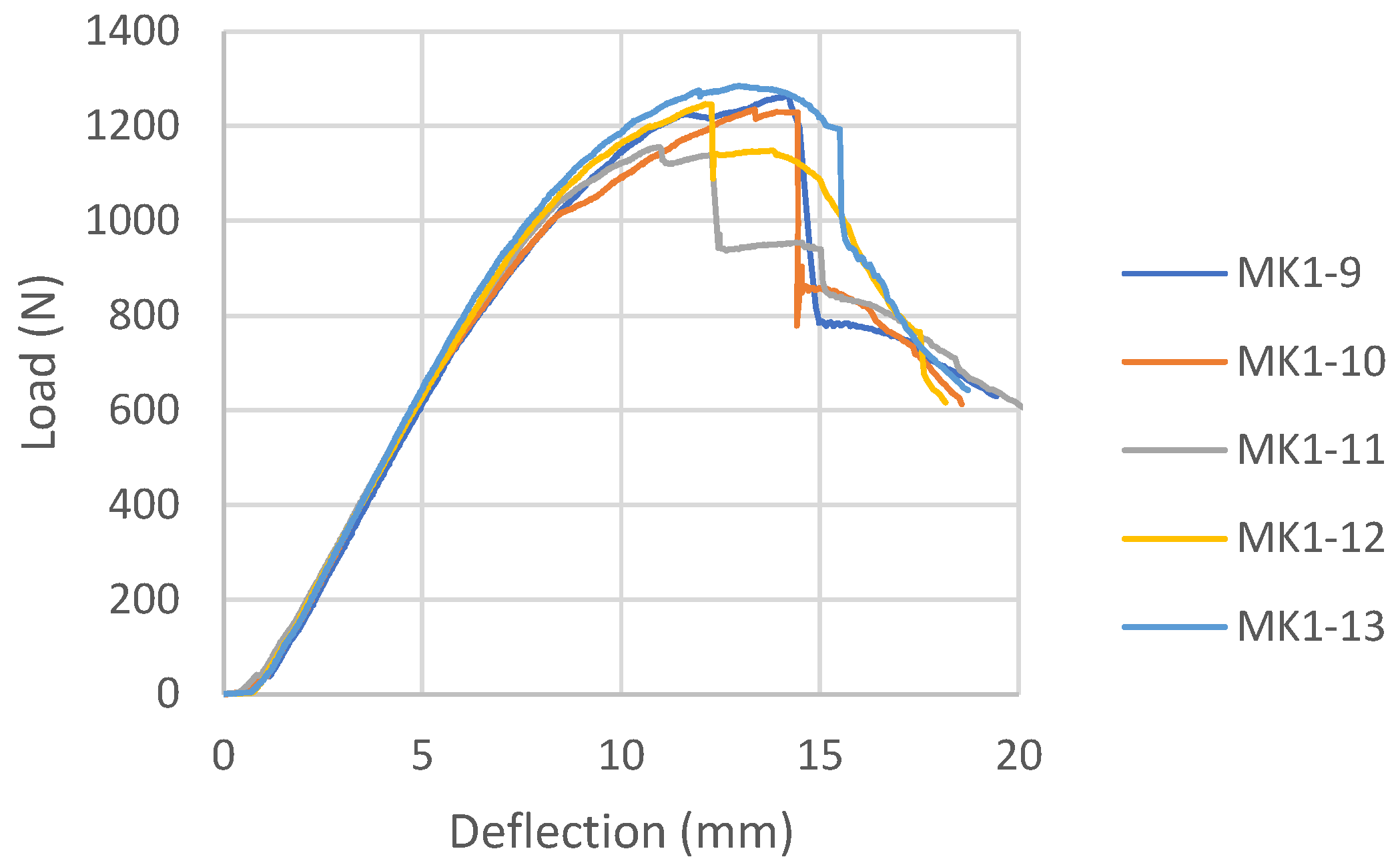
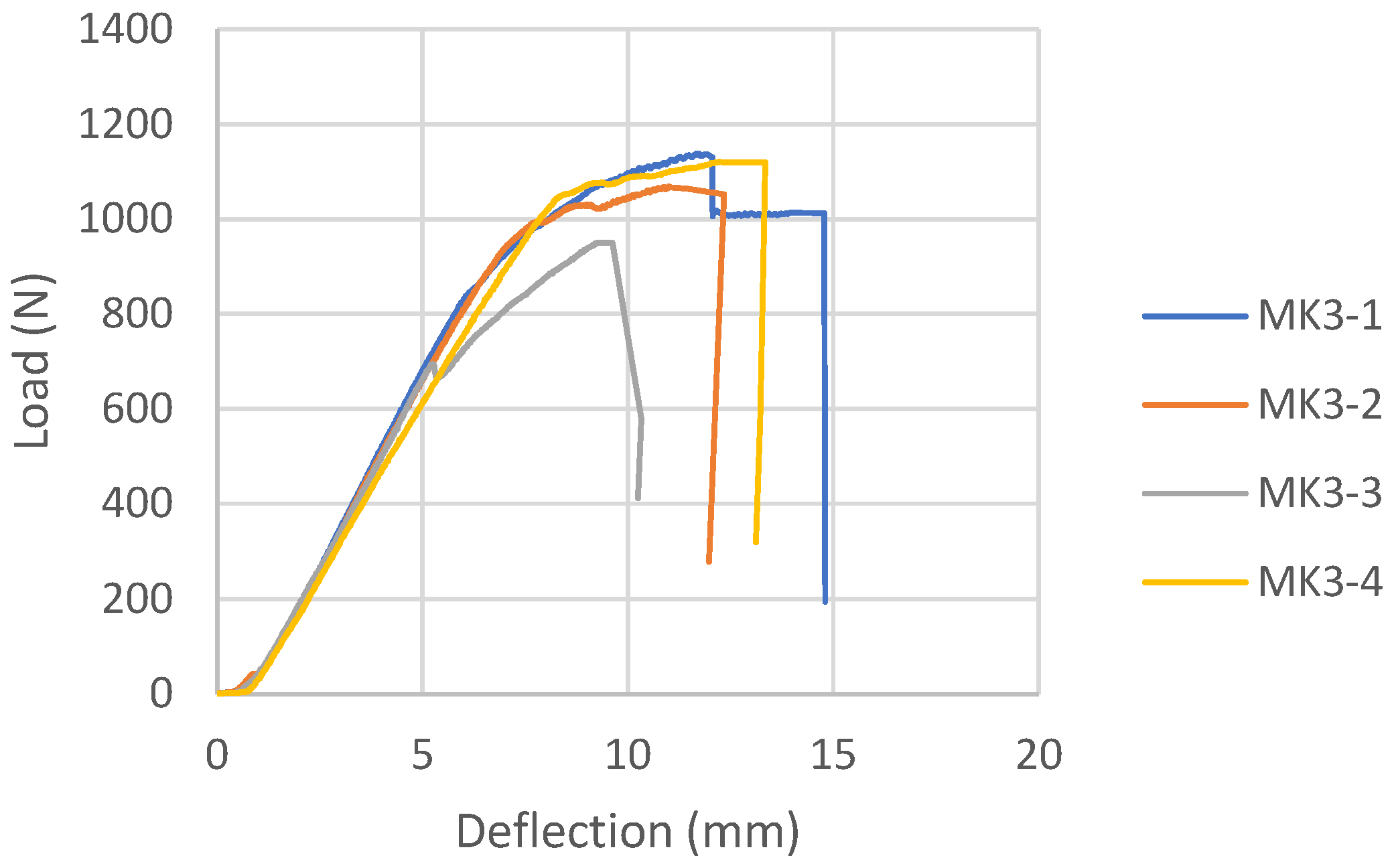
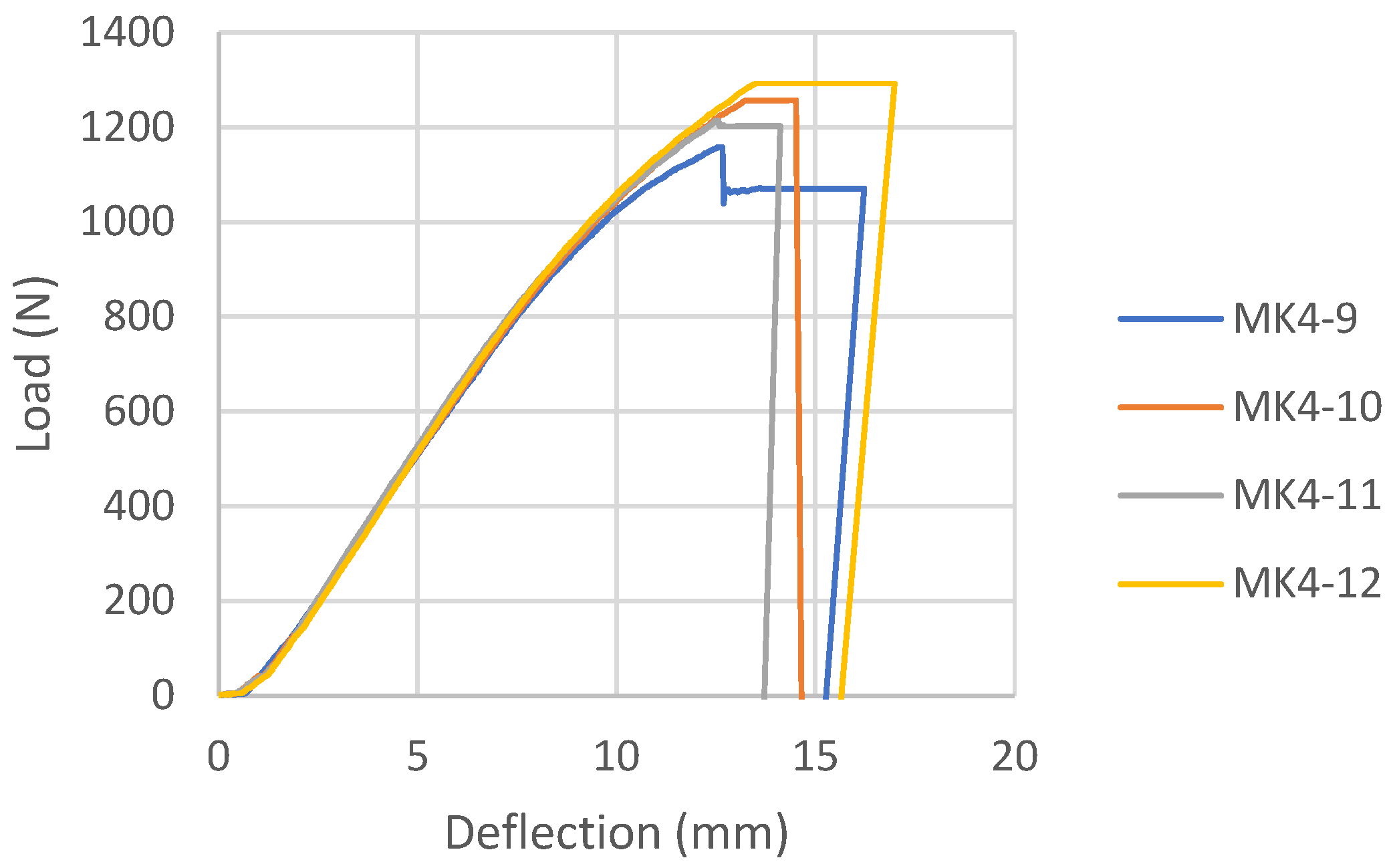
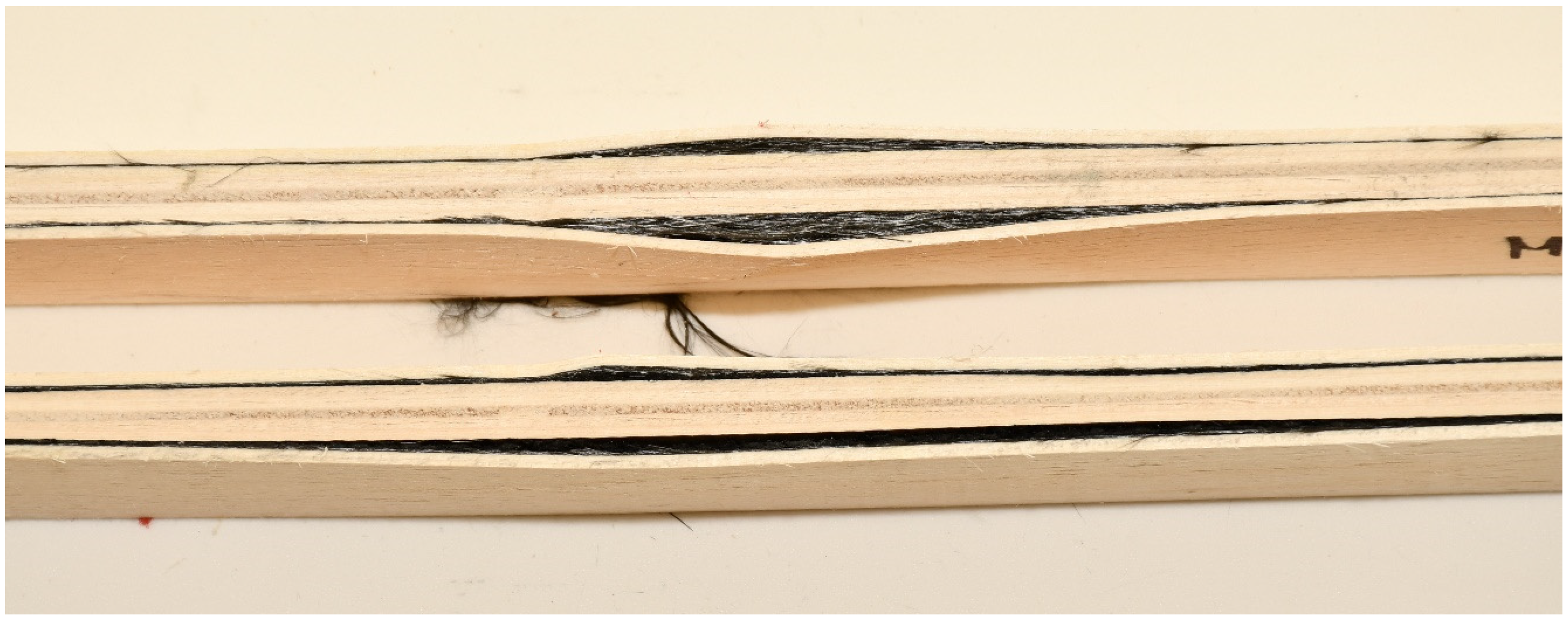
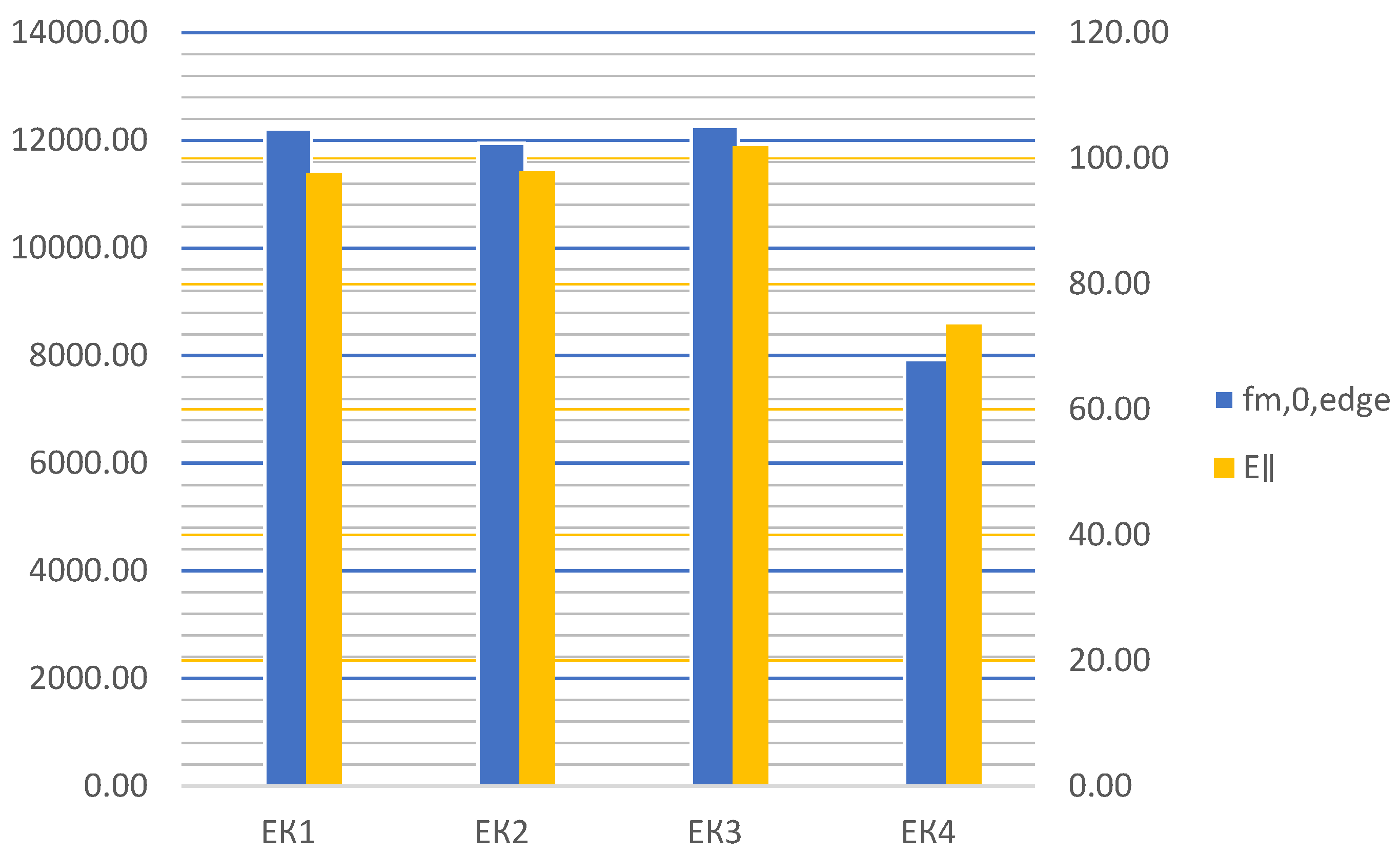
| Technical Properties | Epoxy [34] | MUF [35] | ||
|---|---|---|---|---|
| Resin—A | Hardener—B | Resin—A | Hardener—B | |
| Density ρ (20 °C) (g/cm3) | 1.05 | 1.12 | 1.28 | 1.07 |
| Brookfield viscosity (mPa·s (25 °C)) | 17,000 | 110 | 10,000–25,000 | 1700–2700 |
| Dry matter content (%) | 67.80 | |||
| Gel time (at 100 °C) (s) | 110 | 45 | ||
| Technical Properties | MapeWrap C UNI-AX 300 [37] |
|---|---|
| Mass (g/m): | 300 |
| Density (kg/m3): | 1800 |
| Equivalent thickness of dry fabric (mm): | 0.164 |
| Load-resistant area per unit of width (mm2/m): | 164.3 |
| Tensile strength (MPa) | ≥4900 |
| Combination | u (mm) | F (N) | SD (%) | CoV (%) | (N/mm2) | E (N/mm2) | SD (%) | CoV (%) |
|---|---|---|---|---|---|---|---|---|
| EK1 | 13.68 | 1828.56 | 99.52 | 5.44 | 97.71 | 12,214.47 | 601.04 | 4.92 |
| EK2 | 12.18 | 1923.69 | 106.92 | 5.56 | 97.98 | 11,943.99 | 497.70 | 4.17 |
| EK3 | 12.42 | 1924.63 | 73.45 | 3.82 | 101.97 | 12,256.66 | 461.63 | 3.77 |
| EK4 | 15.93 | 1299.88 | 150.91 | 11.61 | 73.54 | 7925.08 | 280.80 | 3.54 |
| Combination | u (mm) | F (N) | SD (%) | CoV (%) | (N/mm2) | E (N/mm2) | SD (%) | CoV (%) |
|---|---|---|---|---|---|---|---|---|
| MK4 | 12.87 | 1123.47 | 100.13 | 8.91 | 78.66 | 9215.47 | 1021.49 | 11.08 |
Disclaimer/Publisher’s Note: The statements, opinions and data contained in all publications are solely those of the individual author(s) and contributor(s) and not of MDPI and/or the editor(s). MDPI and/or the editor(s) disclaim responsibility for any injury to people or property resulting from any ideas, methods, instructions or products referred to in the content. |
© 2023 by the authors. Licensee MDPI, Basel, Switzerland. This article is an open access article distributed under the terms and conditions of the Creative Commons Attribution (CC BY) license (https://creativecommons.org/licenses/by/4.0/).
Share and Cite
Sokolović, N.M.; Gavrilović-Grmuša, I.; Zdravković, V.; Ivanović-Šekularac, J.; Pavićević, D.; Šekularac, N. Flexural Properties in Edgewise Bending of LVL Reinforced with Woven Carbon Fibers. Materials 2023, 16, 3346. https://doi.org/10.3390/ma16093346
Sokolović NM, Gavrilović-Grmuša I, Zdravković V, Ivanović-Šekularac J, Pavićević D, Šekularac N. Flexural Properties in Edgewise Bending of LVL Reinforced with Woven Carbon Fibers. Materials. 2023; 16(9):3346. https://doi.org/10.3390/ma16093346
Chicago/Turabian StyleSokolović, Neda M., Ivana Gavrilović-Grmuša, Vladislav Zdravković, Jelena Ivanović-Šekularac, Darko Pavićević, and Nenad Šekularac. 2023. "Flexural Properties in Edgewise Bending of LVL Reinforced with Woven Carbon Fibers" Materials 16, no. 9: 3346. https://doi.org/10.3390/ma16093346
APA StyleSokolović, N. M., Gavrilović-Grmuša, I., Zdravković, V., Ivanović-Šekularac, J., Pavićević, D., & Šekularac, N. (2023). Flexural Properties in Edgewise Bending of LVL Reinforced with Woven Carbon Fibers. Materials, 16(9), 3346. https://doi.org/10.3390/ma16093346







